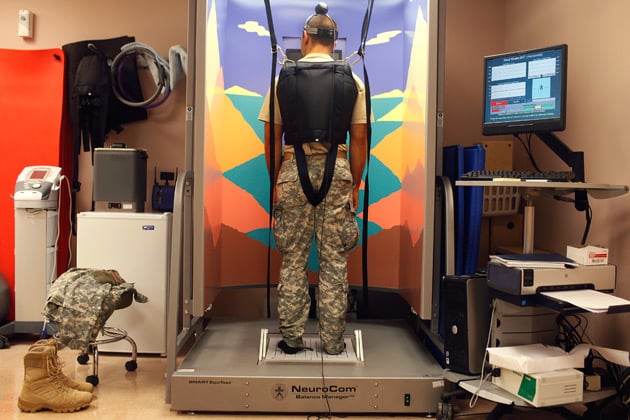Traumatic brain injuries have been called the signature injury of the wars in Iraq and Afghanistan, affecting more than 155,000 men and women in uniform.
But these traumas don’t always have outward signs, making them difficult to diagnose. Right now, tests to detect them can be expensive or require sophisticated medical equipment, such as CT scanners. The Automated Neuropsychological Assessment Metrics, or ANAM, a computerized cognitive test the military administers to troops, has never been scientifically proven to work.
New technologies on the horizon may make testing for brain injuries faster, easier and more portable. These tests — which rely on objective physical measures of trauma, such as bleeding in the brain or markers in the bloodstream — could help detect at least some brain injuries in real time.
Not all traumatic brain injuries cause bleeding, but those that do require medical attention — fast. In the past month, two handheld devices that use light to detect bleeding in the brain have inched toward availability. The FDA just approved the InfraScanner, a battery-powered device developed by the Office of Naval Research (ONR). Also, a team of scientists at the National Institute of Health (NIH) and the Center for Neuroscience and Regenerative Medicine recently published a paper on their own detector. Both devices would allow medics to administer basic tests in the field, identifying soldiers who needed further testing.
“I want this to be a device that some soldier who has no training can take out of the back of a Humvee and use to tell if a person has a hematoma,” said lead author Jason Riley, an NIH scientist who specializes in optical and brain imaging.
The devices work because pools of blood in the brain absorb and reflect light differently than normal brain tissue. By shining a particular wavelength of light — near infrared — onto different parts of the head, the device can spot life-threatening bleeds, or hematomas.
The InfraScanner has been used in Europe for several years, and detects about 75 percent of all hematomas picked up by a CT scan. It takes measurements at locations on both sides of the head, comparing each side with the other to detect anomalies (here’s a video of how it works). The device must be held still to obtain accurate readings, because motion gets picked up as unwanted “noise” that interferes with the signal.
The NIH device, still in the prototype stage, moves over the whole head and uses that “noise” as a baseline to compare changes in blood volume (dramatic spikes indicate a brain bleed). According to Riley, this motion-based sensor produces a more complete image, allowing the device to detect bleeding that spans both sides of the head.
Both devices would work quickly, yielding results in only a few minutes. The next NIH prototype will cost a few thousand dollars, but the inventors hope the final version will cost a few hundred. Each InfraScanner costs $15,000.
In addition to tests that measure amounts of bleeding in the brain, scientists are also developing ways to detect changes in blood chemistry caused by brain injuries. Doctors have designed a new blood test that registers specific proteins released into the bloodstream after a trauma to the head, and a preliminary army study found the test detected even mild traumatic brain injuries with 90 percent accuracy. Like the infrared detectors, the screen would mostly act as a triage tool, helping medics decide who needs further tests.
“We do blood tests all the time for all kinds of diseases,” said Linda Papa, lead author of the study and an emergency physician at the Orlando Regional Medical Center. But right now, there is no widely available blood test for the brain.
That might change in the next few years. Last year a biotech company called Banyan Biomarkers was awarded $23 million from the Defense Department to develop a blood test that detects brain trauma. The company, founded by two former faculty members at the University of Florida, has collaborated with Papa and other scientists to study several different protein fragments produced by the injured brain. The army study, which measured a protein called glial fibrillary acidic protein that rises sharply after a trauma, is their latest, most successful attempt.
Though promising, most of the new testing options won’t be ready for the battlefield for some time.
InfraScan is working on a “ruggedized” version of its handheld device for use outside of hospitals or ambulances that is expected to be out next summer. The NIH device must go through several rounds of clinical testing, and Riley expects it will not be on the market for at least five years. It also will take five years or more to win FDA approval for trauma-detecting blood tests.












